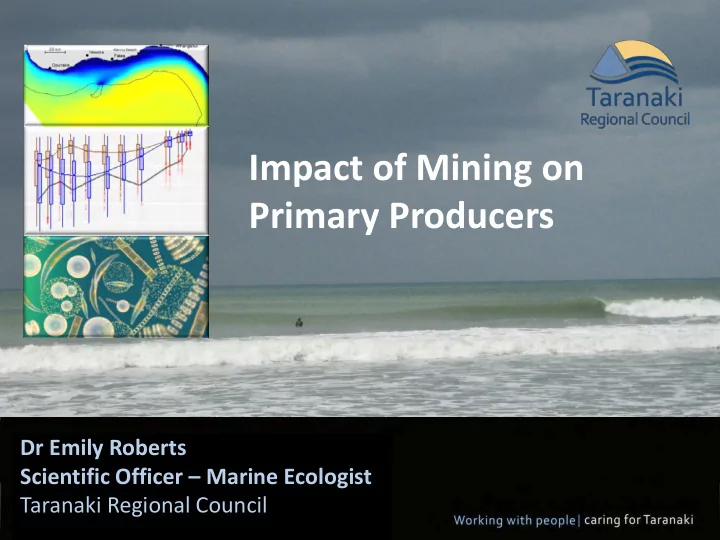

Impact of Mining on Primary Producers Dr Emily Roberts Scientific Officer – Marine Ecologist Taranaki Regional Council
Primary Producers Introduction • Euphotic zone • Benthic microalgae • Phytoplankton Concerns • Scale • Nutrient versus light limitation Suggestions • Scale of risk assessment • Adaptive management • Monitoring
Intro: Euphotic Zone Definition: • Euphotic Zone Depth: light declined to 1% of surface value • Compensation depth: o 24h mean photosynthesis = 24h mean respiration Pinkerton (2014) Predicting the effects of ironsand mining on optical properties of the STB
Intro: Euphotic Zone Pinkerton (2014) Predicting the effects of ironsand mining on optical properties of the STB
Intro: Euphotic Zone Natural Mining
Intro: Phytoplankton Relative average (2 year) light in water column: (% of surface?) Natural Compensation irradiance: ~1% Mining: Site A Pinkerton (2014) Mining: Site B
Intro: Benthic Microalgae Average (2 year) light @ seabed: mol photons m -2 d -1 Natural Compensation irradiance: 0.4 mol photons m -2 d -1 Mining: Site A Pinkerton (2014) Mining: Site B
Intro: % Decrease over South Taranaki Bight Average Mining Site A Mining Site B Benthic microalgae: Light @ seabed 51% 59% Phytoplankton: Light in water column 8% 15% Pinkerton (2014) Phytoplankton primary production 4% 8% Total (B+P) primary production 5% 12% Energy flow to benthos 9% 16%
Concern 1: Scale STB: 12,500 km 2 Plume: ~800 km 2 Plume = <7% STB
Concern 1: Scale Consent Condition (April 2014): 9 (f) vii. No more than minor impact on STB phytoplankton abundance and distribution attributable to optical property changes arising from TTR’s operations.
Concern 1: Scale • Plume shifting • Operations • Water masses • Seasonal • Nutrient limitation • High uncertainty • More variable pulses of phytoplankton Require: Conditions minimize knock on food web effects
Concern 2: Nutrient vrs Light Discussion: Nutrient limitation, e.g.: • McClary, Statement of Evidence, p33, Point 168 • Pinkerton, Optical Properties Report, Point 14 • Huber, Hearing Transcripts, p637 • Venus, Hearing Transcripts, p1883 Clarify: Nutrient and light limitation of phytoplankton growth
Concern 2: Nutrient vrs Light Some of year: Phytoplankton growth N limited When phytoplankton N limited: decrease light without effecting growth Do not know: • Extent: phytoplankton growth limited by N? + ? • Extent: phytoplankton rely on NH 4 • Point: growth switch from nutrient to light limitation? • Area of plume: nutrient to light limitation?
Concern 2: Nutrient vrs Light N limitation of phytoplankton growth: important Current lack of info: Cannot use to imply plume minor impact on primary productivity Requires robust approach: assess impacts of plume: • Risk assessment • Consent conditions • Adaptive management • Monitoring
Suggestion 1: Scale of Risk Assessment Provide comparative estimates of primary productivity values over median footprint of plume: mining vrs non-mining • Required: assess/manage potential foodweb impacts • Values: inform monitoring effort & design
Suggestion 2: Adaptive Management Use adaptive management approach: manage potential impacts mining on PP • Model: management tool • Validated: appropriate monitoring • Model output: development trigger values (SSC & optical) • Spatial scale
Suggestion 3: Monitoring Develop robust monitoring programme: enable management risk in relation to primary producers • Currently: plan proposed monitoring phytoplankton & benthic microalgae = limited: • Benthic microalgae chlorophyll a: Condition 79 • Primary productivity (incl. light) – Conditions 83 & 131 (Venus, p1884 : only light?) • Joint Expert Reports ‘Optical’ & ‘Benthic 2’: Macrofauna: o Valuable: detecting when impact occurred o Limited: confirms impact in hindsight
Suggestion 3: Monitoring Develop predictive model: • Forecast risk • Inform implementation of appropriate trigger values • Validated during baseline monitoring • Monitoring: determine: o Effects of SSC on primary productivity o Switch nutrient to light limitation of phytoplankton growth • Phytoplankton physiologist/modeller on TPRG
Thank You Dr Emily Roberts Scientific Officer – Marine Ecologist Taranaki Regional Council
Recommend
More recommend